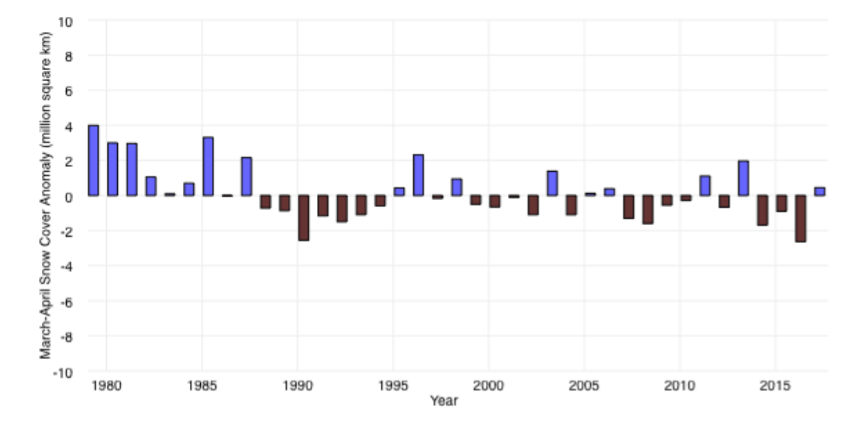NOAA: Climate Change – Spring Snow Cover
Author: LuAnn Dahlman
Records from the last five decades show that on average, spring snow is disappearing earlier in the year than it did in the past, with the most rapid declines in snow-covered area occurring in June. Across the Northern Hemisphere, the total area covered by snow during March and April has also shrunk over time.

Measuring snow extent
Beginning in the 1960s, weekly maps of snow extent in the Northern Hemisphere were prepared from satellite imagery. Now, satellites provide daily maps of snow cover for both hemispheres. Ground observations, precipitation gauges, and weather stations with pressure-sensitive “pillows” measure the amount of snow on the ground and validate the satellite maps. The graph above shows how the average extent of snow cover each March and April compares to the long-term average extent for those months.
Change over time
Despite occasional positive anomalies tied to natural variability in atmospheric circulation patterns, springtime (April–June) Northern Hemisphere snow cover has declined. Records dating back to 1967 show pronounced extent reductions since 2005.
Impacts of snow loss
About one-third of Earth’s land surface is covered by snow for some part of the year. The bright white covering affects global conditions by reflecting solar energy away from surfaces that would otherwise absorb it. Therefore, the earlier decrease in snow cover increases the amount of sunlight absorbed by Earth, and in turn, surface temperatures. In step with earlier dates of spring budburst for many plant species, reduced spring snow cover is a sign that winter conditions are lasting for a shorter period while growing seasons are getting longer.
At regional and local scales, water resource managers, flood forecasters, and farmers are intensely interested in knowing how much water is in snow and when it will melt. Locally, snow provides moisture to soil and plants. On a larger scale, runoff from melting snow feeds streams and rivers that supply water for agriculture and cities. Knowing when and how quickly snow will turn to water is essential for forecasting if water from snowmelt will soak into the ground or cause flooding. In managed watersheds, earlier melting of snow can change when and how much water is available for various uses.
Recognizable patterns of climate variability such as the El Niño-Southern Oscillation and the Arctic Oscillation can affect the amount of snow that falls each year. In different phases of these back-and-forth patterns, some regions receive abnormally large or small amounts of snow. On average, however, despite variations in mid-winter snowfall, Northern Hemisphere snow is melting earlier in the year.
References
Mudryk, L., Luojus, K., Helfrich, S. (2018). Terrestrial snow cover in the Arctic [in State of the Climate in 2017]. Bulletin of the American Meteorological Society, 99(8), S87–S88.
Robinson, D.A. (2018). Northern Hemisphere continental snow cover extent [in State of the Climate in 2017]. Bulletin of the American Meteorological Society, 99(8), S22–S23.
Robsinson, D. (2015). Northern Hemisphere Continental Snow Cover Extent: 2015 Update (pdf).
Rutgers University Global Snow Lab, Data History. Accessed August 29, 2011.
United States Department of Agriculture National Resources Conservation Service, SNOTEL Data Collection Network Fact Sheet. Accessed August 29, 2011.